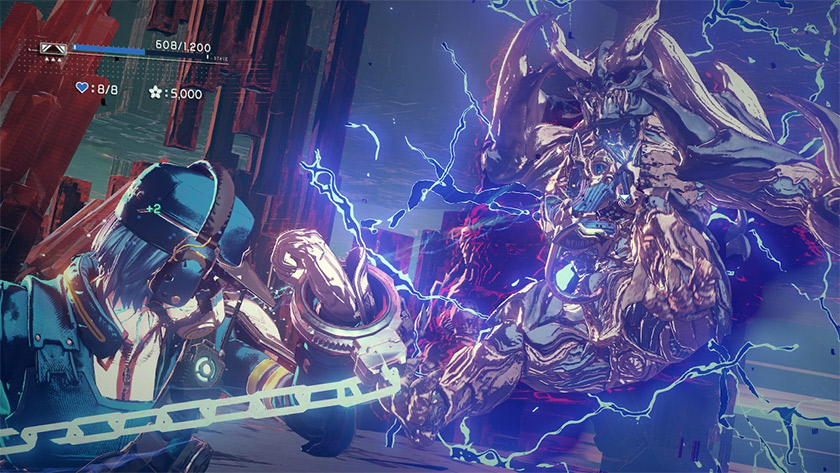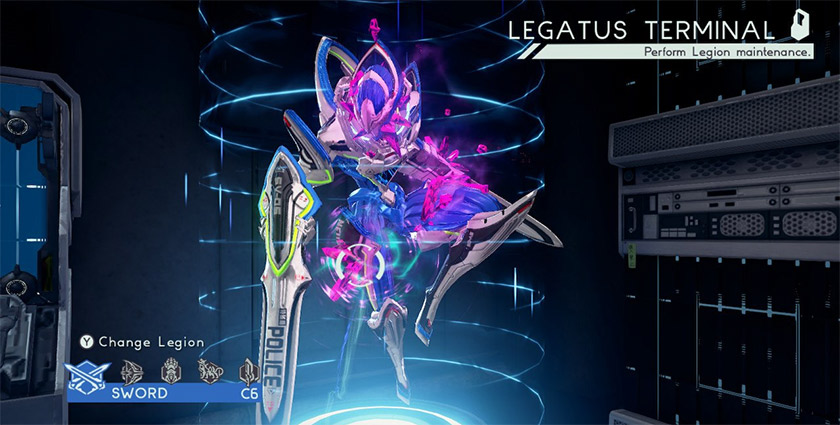Astral Chain

Astral Chain feels like the culmination of every major PlatinumGames action title that came before. It is not somehow larger in scale or more epic – its final boss is certainly a reversal of scale of Bayonetta’s escalation – but it implements small lessons and bits from just about every major entry prior.
This does not turn the game into something derivative, however. Whereas a licensed “Work-for-Hire” title like Transformers: Devastation felt like it was a barely modified variant of Bayonetta, Astral Chain feels unlike any other game out there. Of course, such a statement typically comes with hyperbole, as if to suggest that it’s going to blow your mind with how unique and revolutionary the game is. This statement is obviously untrue if it somehow carries influence from several other games from the studio.
The best way I can describe it is that Astral Chain certainly feels like an action game as you’d expect it to, but if you were to try and make direct correlations to any other big name in the genre – be they from PlatinumGames, Capcom, or one of the myriad smaller studios dabbling in the genre – you’d fail to find that one-to-one similarity. It is in this fashion that it feels unlike any other game, despite drawing from so many others.
Bayonetta’s emphasis on dodging is the first thing that players will no doubt recognize. Though a perfectly-timed dodge in that game rewarded the player with slowed down foes, nearly every action game following had sought to reward such intentional and well-timed evasion with some additional or alternate benefit. In Nier: Automata, the game Takahisa Taura designed before directing Astral Chain, a perfectly-timed dodge resulted in an opportunity to launch a special attack towards your foe, often by launching them into the air where you could “juggle” them. This often took protagonist 2B out of harm’s way, allowing her to relentlessly strike at her now defenseless opponent in mid-air. It was a reward for skilled play, but it took a different form than Bayonetta’s slowed-down Witch Time.
In Astral Chain, a perfectly-timed dodge is the first ability unlocked on the player’s Legion, the Astral creature bound to their service. Avoid an opponent’s swing at the right time and the game will briefly slow-down, the background dimming as a bright light shines over the protagonist. This indicates an opportunity to synchronize with your Legion, launching an offensive simultaneously.
This synchronization is where we see Astral Chain deviate in philosophy from most of its brethren. Whereas games like Bayonetta, Transformers: Devastation, and Metal Gear Rising: Revengeance focus on intricate combos, Astral Chain’s attacks are relatively simple. The player isn’t supposed to be throwing themselves into the middle of combat as their protagonist is far less super-human. Attack “combos” no longer require precise combinations of buttons and timing. Just a string of button-mashes that leave the player open and vulnerable at the end. At least, until the player is able to synchronize with their legion and launch into a simultaneous strike at the end of one such “combo”. The best use of a player’s offense is to take advantage of an opponent’s vulnerability to launch into a more devastating attack with your Legion.
It’s a seemingly tenuous connection, but it is here that I begin to draw lines between Astral Chain and another PlatinumGames dot: The Wonderful 101. Hideki Kamiya’s baby of the WiiU also had less emphasis on fanciful combos, button sequence memorization, and precision timing. It instead focused on having the right tool for the job, using the chromatic team of Wonders in specific combat and platforming scenarios. A giant armored foe with spikes? Use Wonder Pink’s whip to lash and latch onto those spikes, tearing the armor free and making it susceptible to your onslaught of attacks. Hasty enemies leaping about the environment faster than you can strike them? Toss a Wonder Black brand bomb to slow time and make them vulnerable. Different opponents had different tricks to them, and the combat system was more interested in the player swapping Wonders and their tool sets throughout each fight rather than testing how many combos had been memorized or the twitch of their reflex. The skill-floor remained low without sacrificing player engagement or dragging the skill-ceiling down.

Combat in Astral Chain rarely demands the player stick to one Legion so specifically, save for the occasional opponent requiring a unique skill here and there. Quite the contrary, the player is able to customize each Legion to fit certain scenarios or uses matching that player’s style. For example, I gave my Arm Legion the ability to break free of its chain and unleash a flurry of blows upon the opponent, freeing me up to call out another legion and prepare for my next phase of attack. Perhaps starting with the Beast Legion’s Howl ability to stun nearby opponents would make for a better first step, allowing the arm Legion easy targets before swapping out to the Sword Legion. Unleash the whirling Round Blades orbiting the Legion before executing an Auto-Bind, each foe being cut and chipped away at as the armored and blue monster lassos them into a trap.
Not that the game even requires this step-by-step chain of commands. This is merely me trying to make the most of the systems available, to subdue the opponent with a series of easy-to-execute actions. Astral Chain inherited Wonderful 101’s accessibility while still offering a high skill-ceiling for those hoping to dig deep into what it had to offer, which is perhaps the best thing it could have inherited from any other PlatinumGames title.
There’s also the matter of “drawing circles” with the right thumbstick in order to create a chain binding. While “Auto-Bind” automatically bounds opponents in range for a short time, it also prevents the player from moving during that quick bind. This means the player can be struck or interrupted mid-bind, no opportunity to evade. It’s this sort of minimal cost that a high-level player is going to consider, choosing to implement the right thumbstick similarly to The Wonderful 101 rather than the game’s offered shortcut. To most players, auto-bind is no doubt going to be a staple. Higher skilled players may not even keep it, opting instead for other abilities they consider more useful or situational.
Just as with Wonderful 101, that lower skill-floor does not negate the higher tier play that PlatinumGames so exquisitely caters to.
There’s one final, blatant mechanic hijacked by the Sword Legion, and that is the slicing and dicing of Metal Gear Rising: Revengeance. Though it is one of the PlatinumGames titles I am least familiar with, it doesn’t take much to recognize the unique ability to direct your clean cut with a blade, severing invisible ties and connections naked to the human eye. Just another tool in PlatinumGames’ ever growing toolbox, implemented as a single Legion’s ability to use during select platforming and combat segments.
Which is where we branch into the unique elements of Astral Chain. Up until now I’ve largely been covering how the game takes influence from the studio’s catalogue regarding combat, but there’s one more element borrowed while simultaneously forging new pathways for the studio. Astral Chain may not be a role-playing or open-world game, but it certainly possesses a series of side-quests the player can opt into taking within its uniquely constructed world.
It is this optional content that I believe helps differentiate the title from its brethren, as every case serves to fit the player’s identity as a police officer. Protecting the citizenry from the invading forces of Chimeras, locating lost kittens, obtaining balloons stuck in trees, eavesdropping on ne’er-do-wells, and carrying a supremely stacked ice cream cone to an upset child. These are just a sampling of the different activities the player can undertake to keep order upon the Ark, last sanctuary of humanity upon Earth. The player’s score is boosted for every empty can they recycle, and points are removed from their final score for actions such as crossing the street illegally. Act like a police officer and get rewarded. Violate those laws you’re supposed to uphold and be punished. Where other PlatinumGames have largely been purely combat focused, Astral Chain always takes a step back to remind the player of their other responsibilities to the Ark and its population.
Director Takahisai Taura took the quest system he helped implement in Nier Automata’s design, and executed it in Astral Chain in a fashion that feels thematically appropriate while providing a variety of different activities to the player. These quests often appear when the story calms, following an intense series of combat encounters and giving the player the opportunity to explore the world while slowing the pace and loosening the tension. An episodic fashion in which the story is able to continually rise in intensity before once more bursting into an explosive battle, settling into a calm after so that the tension can slowly build once more. Rather than a relentless pace, the game moves steadily and delivers a sense of variety.

Perhaps the only weak part of the game, the player is required to regularly “maintain” their Legion by hovering over the Red Matter and repeating pressing the right-trigger.
Platforming segments complete the game’s amount of content on offer, generating a different form of challenge while rewarding the player for exploration and execution of their Legion’s varied abilities. The chain can be used to latch onto hovering pillars, leaping around corners to access hidden and hard-to-reach chests and items. Gaps and chasms can be overcome by being pulled across by any of your floating Legion, moving walkways with the Arm Legion, or sprinting across crumbling floors with the Beast Legion. Even in exploration of the Astral Plane the player finds themselves working in tandem with their Legions, forging new paths forward and discovering hidden items.
There’s often a sense of exploration in most PlatinumGames titles, but none so varied and thorough as Astral Chain. Even other action games, such as this year’s Devil May Cry 5, have far more basic exploratory puzzles and pathways for observant and nosey players to uncover. Astral Chain takes that very Nintendo approach, where you start with a tool and then think about its many potential uses.
In a single level, you may find yourself entertaining a group of children in a riddle, sneaking through a hologram wall to uncover a hideout of hooligans, leaping across rooftops in order to find secret gateways to the Astral Plane, and fending off hordes of frightening chimeras. It may not be a “true” open-world, but there is a desire to explore the different Ark environments and interact with its populace rather than treat each room and chamber as a new combat arena.
On paper, there are plenty of other role-playing games and similar titles that do the same. Astral Chain isn’t a role-playing game, though. It’s an action game, through-and-through, but it doesn’t feel like anything else on the market. It’s also polished and strong enough to demand the player return over and over.
It really may be one of the strongest titles on the Nintendo Switch.


